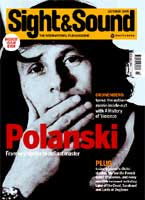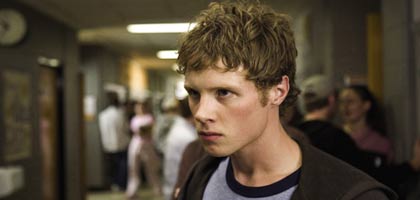
A History of Violence
Germany/USA 2005

Reviewed by Richard Falcon
Synopsis
Our synopses give away the plot in full, including surprise twists.
Tom Stall (Viggo Mortensen) runs a diner in the Indiana town of Millbrook, enjoying a quiet life with his lawyer wife, Edie (Maria Bello), and their teenage son, Jack (Ashton Holmes), and six-year-old daughter, Sarah (Heidi Hayes). Fresh from murdering another family, two casually homicidal criminals attempt to rob the diner, threatening Tom's waitress. Tom responds by disarming and killing them, becoming the reluctant focus of national media as a result. When Carl Fogarty (Ed Harris), a gangster with a scarred eye, arrives at the diner, he claims to recognise Tom as a murderous hood called Joey Cusack, the man who took his eye and whose brother, Richie (William Hurt), is the powerful Philadelphia gangster for whom he works. Tom denies this, but later rushes to his home fearing Fogarty is endangering his family.
Tom rebukes Jack when he suddenly and savagely beats a pair of jocks who have subjected him to a long-term bullying campaign. Fogarty and his henchman confront Tom, demanding that he leaves with them to see Richie. In the ensuing violence, Tom kills the henchman and Jack shoots dead Fogarty before the latter can kill the injured Tom. Recovering in hospital, Tom confesses to Edie that he is Joey Cusack, and that he had renounced crime during an epiphany in the desert after which he emerged with a new identity. Out of hospital, Tom tells the distraught Edie that he has to call on his brother or none of them will be safe. Before he leaves, a fight between the couple turns into sex. In Philadelphia, Tom is driven to his brother's mansion. During the tense reunion it becomes clear that Richie will have to kill Tom for the sake of his kingpin reputation. Tom kills Richie and his goons and returns to his family.
Review
On the face of it, A History of Violence is David Cronenberg's most mainstream, generic and Americanised offering since The Dead Zone (1983). Its remarkable achievement, though, lies precisely with the director's deployment of nearly archetypal narrative material: A History of Violence is a fantastically sure-footed film both rooted in and wholly self-conscious about the powerful pleasures audiences take in violent Hollywood thrillers. The chilling opening scene has two casually violent criminals bickering outside a motel. The revelation that they have slaughtered the family inside is delayed while we observe the tetchiness of two men bored with a job that comes too easy to them. One enters the building and calmly executes a little girl who has just emerged into the midst of the atrocity. Despite invoking famous scenes of children being shot by remorseless villains (Assault on Precinct 13, Once Upon a Time in the West), there is no amoral Tarantino-style glee in this set-up or a feeling that Cronenberg is merely setting out to shock. Instead this casual eruption of violence into the workaday world sets up an intense mood of dread that permeates the rest of the film. Each subsequent detailed outburst of violence focuses on two figures with whom we are invited to identify: Viggo Mortensen's quiet man hero, Tom, and his son, Jack.
When the two thugs try to stick up Tom's diner, Cronenberg takes a scene of righteous, heroic violence of a kind that has been ritualised by Hollywood in countless movies before. To quote Ed Harris' sinister gangster Fogarty, "he goes all Dirty Harry on us". But Cronenberg treats the violence with such hyperreal detail, down to a close-up of the bullet-mutilated head of one of the corpses, that we instantaneously lose our bearings as we move through a complex of responses that include relief, excitement, titillation, shock, guilt and amusement at the scene's bravura breach of aesthetic, generic and moral boundaries. Directing a screenplay adapted from a graphic novel (written by John Wagner, co-creator of Judge Dredd), Cronenberg may have drawn inspiration from the way comic-book panels freeze and fetishise the split seconds of violent action. But part of this film's effect derives from the fact that Cronenberg has shown no interest before in exploiting generic tropes of screen violence and the feeling that this sudden eruption has more to do with the irrationalist, id-releasing infections and scary alternative realities of his earlier films than it does with a sudden conversion to the ethics of vigilantism.
A History of Violence 's publicists have asked that reviewers do not reveal the film's major plot twist. (Those wishing to remain innocent of this should read no further.) In truth, though, the narrative admits only two possibilities: that Tom is really the victim of a case of mistaken identity when Fogarty arrives and identifies him as a vicious killer; or that he is a gangster who is trying to hide from his past. The first of these alternatives switches the film into Hitchcockian ‘wrong man' mode; the second propels it into the fatalism of such noir classics as Out of the Past and Lang's The Big Heat (the boiling coffee Tom uses as a weapon is surely no accident).
When European arthouse directors such as Michael Haneke (with Funny Games) claim they are morally ‘deconstructing' Hollywood movie violence, they doom themselves to failure by their desire to punish audiences through subverting or negating Hichcockian suspense. Cronenberg instead takes the noir route, and effortlessly invokes a long list of thrillers that include Straw Dogs, Point Blank and Cape Fear. He also climaxes each generic violent confrontation with a sharp, comically exaggerated, reminder of his hero's near-superhuman facility with violence. For all the film's real grip as a thriller, Cronenberg is right to claim that it is neither moralising, nor ironic, but just "funny". But the laughter provoked is perhaps the subtlest and most credible movie critique of audiences' enduring investment in rituals of screen violence to date. Just to make sure we don't miss the point, the film has Jack turning on his tormenters in school in another gratifyingly familiar scene of a worm turning, a superhero shedding his secret identity. But the ensuing beating exhibits slightly too much psychotic relish to remain safely within the comfort zone of most audiences, and when Tom later tells his son not to solve his problem by hitting people, he punctuates his lecture with blows himself.
There is a distance, too, from the mythic American sense of starting afresh and of new beginnings. The film's most telling dramatic scene takes place in the hospital room in which Tom's wife Edie watches him become a stranger in front of her eyes. Mortensen's low-key performance, as he subtly shifts persona from family man to efficient killer is remarkable, as is Maria Bello's reaction of horror as Edie listens to Tom using born-again vocabulary to describe how he walked off into the desert and "murdered" his old self.
The film includes two interesting sex scenes. In the earlier of the two Edie dresses as a cheerleader, indulging a specifically American erotic fantasy of the teenage years she and Tom didn't spend together. In a later, psychologically darker scene, the couple have aggressive sex after Edie discovers Tom's true identity. Bello creates Edie as a strong presence in the film; the focus on her sexuality, particularly in the second of these sex scenes, adds complexity to a character who could have been merely a passive victim of a deception and a generic symbol of home and family.
At the end, Tom, following his climactic, superhumanly adept bout of violence, throws his pistol in a lake, just like Dustin Hoffman in Marathon Man, and returns to the bosom of a family that will now presumably accept his remorseless killing-machine past. Cronenberg's masterful, intelligent and gripping meta-thriller leaves us pondering about our enduringly perverse desire for alternative realities, in which surrogate violent alter egos run righteously and preposterously amok.
Credits
- Director
- David Cronenberg
- With
- Viggo Mortensen
- Maria Bello
- William Hurt
- Ashton Holmes
- Certificate
- 18
- Running Time
- 18 95m 36s
